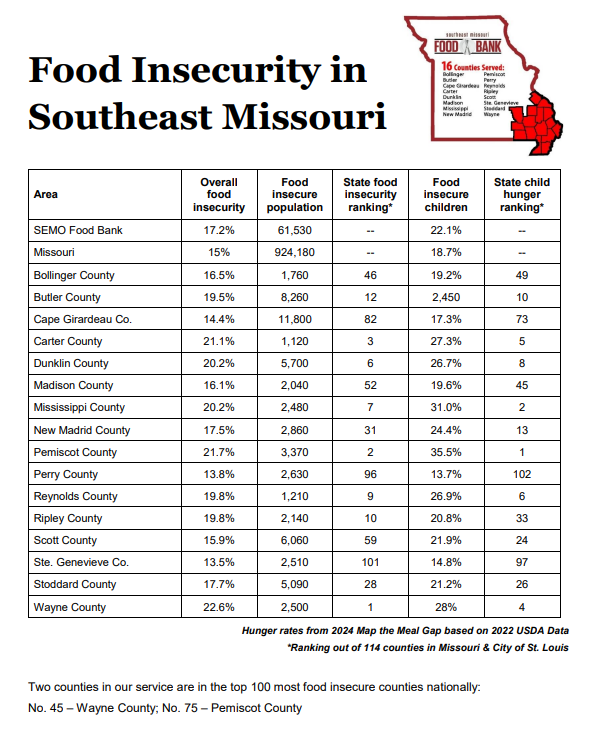SIKESTON, Mo. – The extra amount of money that people facing hunger said they need to have enough food reached its highest point in the last 20 years, according to Feeding America’s annual Map the Meal Gap study. At the local level, Map the Meal Gap finds that across southeast Missouri, an average meal cost $3.46 in 2022 (the most recent year data is available), up from $2.73 in 2019 and $3.12 in 2021.
Southeast Missouri Food Bank is one of more than 200 food banks that are part of Feeding America’s nationwide food bank network.
Map the Meal Gap is the only study that provides local-level estimates of food insecurity and food costs for every county and congressional district. The study builds upon the USDA’s latest report of national and state data, which showed a sharp increase in food insecurity in 2022 amidst historically high food prices and the expiration of many pandemic-era programs. Map the Meal Gap emphasizes the urgent call for all of us to take action.
In southeast Missouri, overall food insecurity rose to 17.2 percent, up from 14.5 percent in last year’s Map the Meal Gap.

“The insights from this year’s study confirm what we hear from people facing hunger: Elevated food prices are making hunger in America worse,” said Joey Keys, chief executive officer of SEMO Food Bank. “We’ve seen this firsthand over the last several years, with people from across southeast Missouri visiting food pantries and distributions for the first time. Seniors and other neighbors living on fixed incomes have been especially hard hit. We’ve heard stories of people having to put items back during checkout, not being able to afford things like meat and fresh vegetables, and skipping meals to stretch their food budget.”
Other key findings of Map the Meal Gap include:
Food Insecurity by Geography:
- Food insecurity impacts communities in every county, parish and congressional district in the U.S.
- Estimated food insecurity levels vary across regions, influenced by factors like unemployment and poverty rate as well as policies and practices rooted in history that continue to hold people back today.
- In Missouri, food insecurity ranges from a low of 22.6 percent in Wayne County to 10.1 percent in St. Charles County. SEMO Food Bank’s service area includes the top three most food insecure counties in the state (Wayne, Pemiscot and Carter).
- Nationally, child food insecurity rates can reach almost 50 percent in some counties. In Missouri, 18.7 percent of children are food insecure, but in SEMO Food Bank’s service area, that number can be much higher. Pemiscot County has the highest rate of childhood hunger in the state at 35.5 percent.
- Rural counties disproportionately experience high levels of food insecurity compared to urban areas. This is true in Missouri, which sees high levels of food insecurity across our rural counties, including right here in southeast Missouri where seven of the top 10 counties for overall and child food insecurity are in our service area.
Income and Food Spending:
- Nearly 50 percent of people facing hunger may not qualify for SNAP benefits due to income thresholds. Here in Missouri, more than 66 percent of people facing hunger may not qualify for SNAP.
- The national food budget shortfall, which reflects the extra money that people who are food insecure report needing to cover their food needs, has hit a record high of $33.1 billion, up nearly 43 percent from the previous year. This translates to $24.73 a week per person, on average.
- Residents of southeast Missouri feel this first-hand, with an estimated food budget shortfall of $40,028,000, or an average of $21.45 per week per person.
Food Costs and Meal Prices:
- The national average cost per meal has increased to $3.99, marking a nearly three percent increase compared to the prior year and reaching its highest point in the last two decades, even after adjusting for inflation.
- Meal costs vary significantly by county throughout the nation and here in Missouri, ranging from $2.91 to $6.67, showcasing the diverse economic challenges faced by communities. In southeast Missouri, the average cost per meal is $3.46, which reflects the high need we see at SEMO Food Bank.
“Map the Meal Gap is a powerful tool that helps us understand the impact of food insecurity from a national to local level and underlines that we can choose to end hunger in America by coming together,” Keys said.
The Map the Meal Gap study is supported by Conagra Brands Foundation and NielsenIQ/NIQ. Additional key takeaways from the report can be found on the Map the Meal Gap website along with an interactive map that details food insecurity by geography, income, race and ethnicity.
Methodology:
Map the Meal Gap uses publicly available data from the USDA ERS, U.S. Census Bureau and Bureau of Labor Statistics to estimate local food insecurity at the county, congressional district and state levels. The study also estimates local meal costs and food budget shortfalls using food price data from NIQ based on the USDA Thrifty Food Plan, and grocery sales tax data for every county and state in the country.
To learn how food insecurity impacts your community, visit FeedingAmerica.org/MaptheMealGap. For more information about Southeast Missouri Food Bank and how to help end hunger in our area, visit semofoodbank.org.
